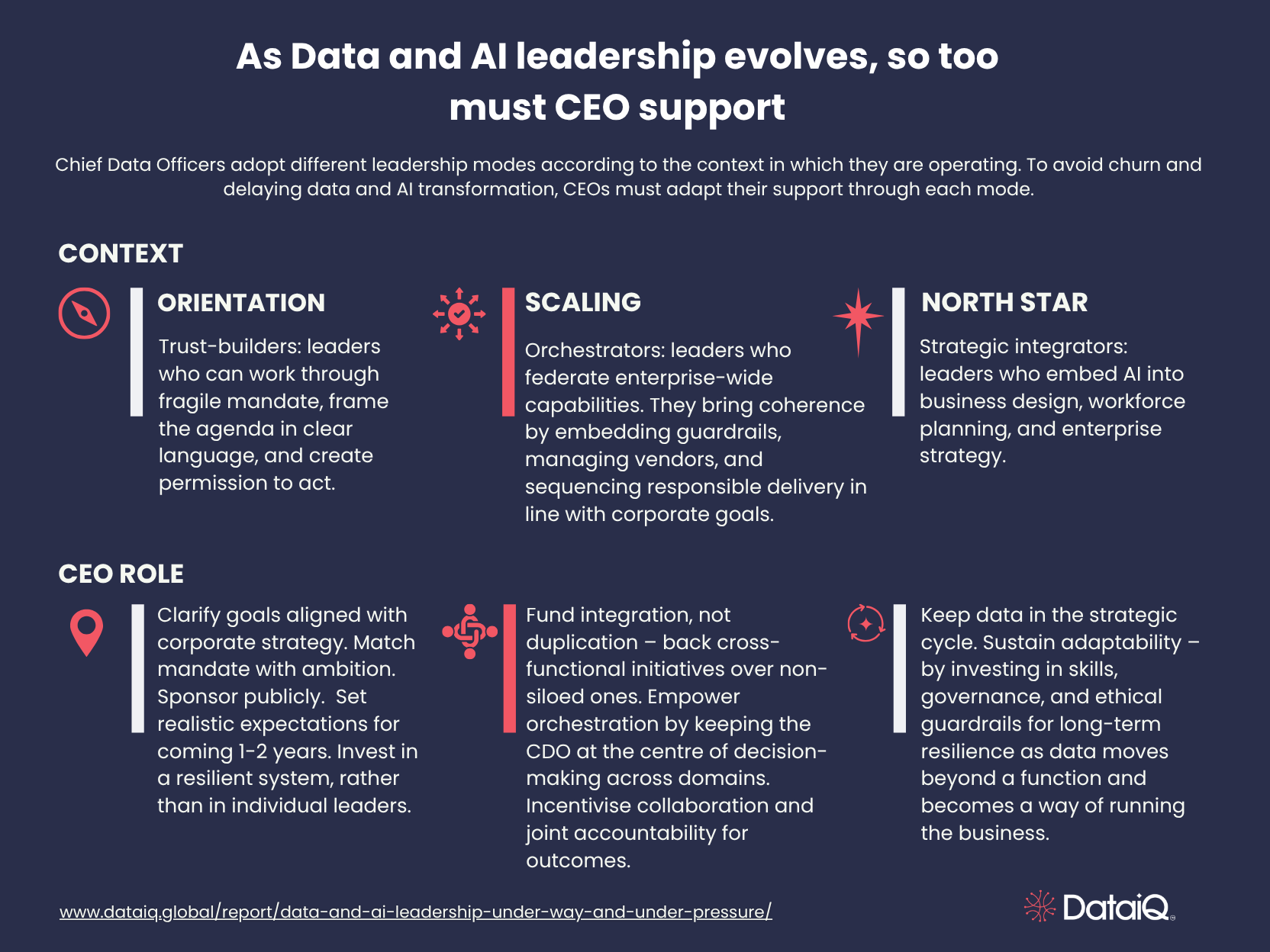The revolving door of data leadership
Why does this happen? It’s not because CDOs lack ambition or skill. It’s because the conditions in which they operate are often impossible.
DataIQ’s Data and AI Leadership: Under Way and Under Pressure report, produced in collaboration with Databricks, captures the reality. Leaders are judged on visible business impact, but many are given neither the mandate nor the sponsorship to deliver it. They face soaring expectations on AI, often from boards impatient for quick returns, but without the authority to align budgets, platforms, or teams.
Meanwhile, DataIQ benchmarking data show how offices scale. Our client-exclusive report Right-Sizing the Data Office, reveals that the average team size is 131 — a figure that aligns closely with Dunbar’s number, the human limit of informal networks. Beyond that, complexity surges. Offices at peak maturity can exceed 277, but they only hold together when there are strong structures: board-level sponsorship, trusted governance, and a culture that sustains collaboration.
The problem is that many CDOs are replaced just as their office hits this point of strain. Growth exposes the limits of informality, but structures are not yet in place. This “messy middle” is when proof-of-concepts stall, vendor costs spiral, and credibility falters. Rather than addressing the conditions, organisations often change the person. The cycle repeats.

Different modes, different traits — but time is non-negotiable
Leadership in data and AI is not uniform. As Data and AI Leadership: Under Way and Under Pressure reveals, different modes call for different strengths:
- Orientation needs trust-builders: leaders who can work through fragile mandate, frame the agenda in clear language, and create permission to act.
- Scaling needs orchestrators: leaders who embed guardrails, manage vendors, and bring coherence when demand outpaces means.
- North Star needs strategic integrators: leaders who embed AI into business design, workforce planning, and enterprise strategy.
Each mode calls for distinct leadership strengths. A leader suited to one may not automatically succeed in another. But across all three modes, one thing holds: they take time to show results. A 1.9-year tenure cuts the ground from under every mode — whether it’s the time needed to build trust, orchestrate coherence, or embed strategic alignment.
The organisational risk
Short CDO tenure is not just a personal career hazard; it is a strategic risk for the organisation.
- Every new CDO resets the agenda, restructures the team, and loses months to re-establishing mandate.
- Business units become sceptical. They’ve seen the promises before, and disengage when governance looks like bureaucracy rather than support.
- Talent churn follows. Teams mirror leadership instability, and the office’s credibility drains away.
- Investment is wasted. Headcount and vendor budgets rise, but impact stalls in the middle ground between ambition and reality.
This is how companies find themselves “investing in data” year after year without ever seeing returns that match the spend.
How to change the tenure trend
The answer is not to cycle through CDOs faster, but to change the conditions in which they are asked to lead.
- Give them mandate equal to the ambition. If you want data and AI embedded in strategy, the CDO must sit at the top table. Our benchmarks show that board-level CDOs lead larger, more resilient offices — average headcount 265, compared to just 54 when access is limited.
- Recognise the messy middle before it hits. When offices approach 150 people, informal ways of working will no longer hold. Leaders need governance that enables autonomy, federated models that distribute delivery, and clear measures of business impact. Without these, failure is baked in.
- Change the clock. Expecting transformation in under two years is unrealistic. The horizon needs to match the reality: three to five years, paced with clear milestones tied to outcomes the business values.
- Build resilience into the system, not the individual. Structures, measures, and operating models must survive beyond a single leader. Otherwise, every departure resets progress, and the organisation remains permanently at the start line.
The bottom line
Short CDO tenure is not just an HR statistic. It is a proxy for organisational maturity. If your CDOs keep leaving in under two years, it suggests your company still treats data and AI as an experiment rather than part of the core operating model.
If CEOs and boards want data and AI to be more than a slide in the annual report, they must create the conditions for data leadership to last. That means mandate, patience, structure, and resilience. Otherwise, the revolving door will keep spinning, and the promise of transformation will remain just a promise.
Right-Sizing the Data Office is available exclusively to DataIQ clients (via the DataIQ Hub).
Download Data and AI Leadership: Under Way and Under Pressure here.





